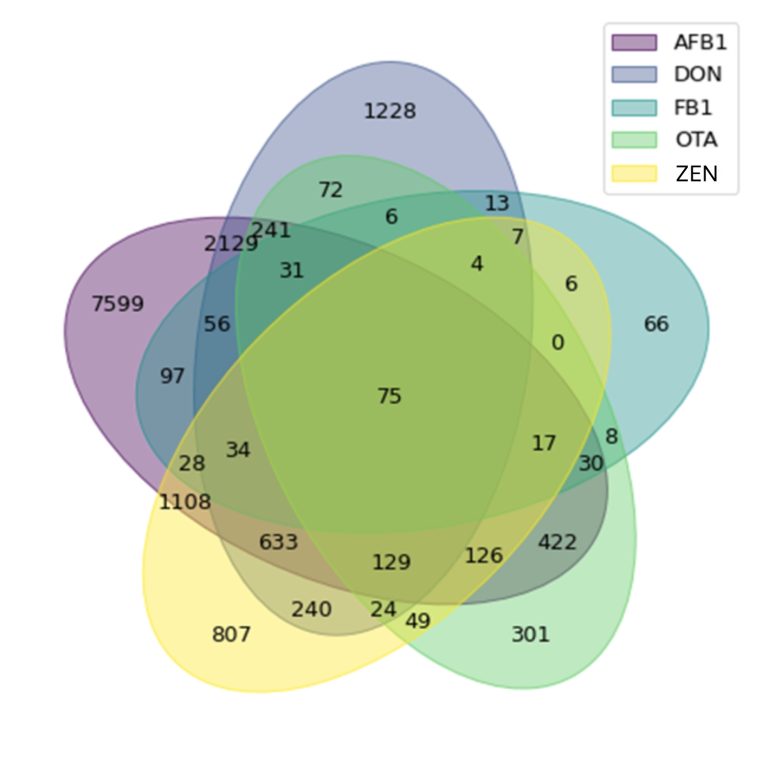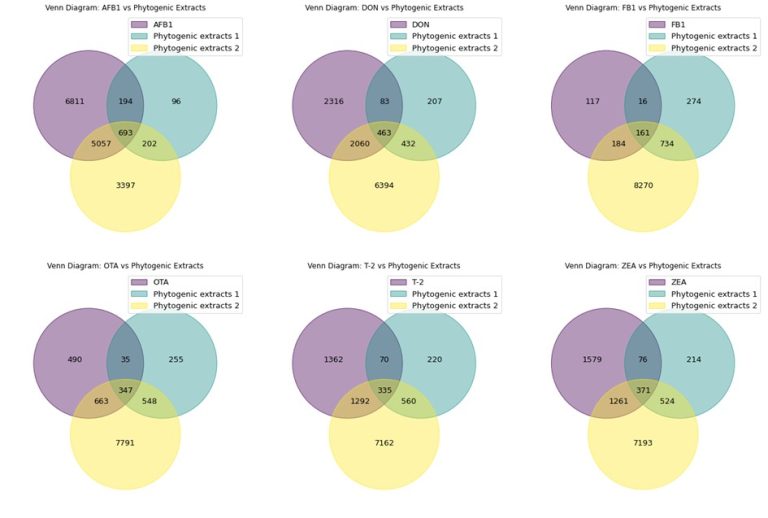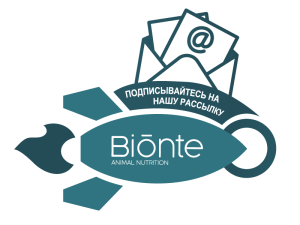Introduction
The presence of mycotoxins in feed poses a significant risk to animal health. (Muñoz-Solano et al., 2024) Its consumption can trigger clinical symptoms that are related to the alteration in the expression of certain genes, which affects key biological processes.
The study of gene expression modification is a fundamental tool to evaluate the impact of mycotoxins and design effective strategies to minimize their adverse effects. In this context, phytogenics, thanks to their active components, have demonstrated their ability to modulate the expression of specific genes in productive species. Consequently, they interact antagonistically with mycotoxins, thus reducing the clinical effects caused and contributing to an improvement in the health status of the animals.
The modification of the gene expression produced by phytogenic extracts focuses on key processes, decreasing oxidative stress, improving gut health, and balancing the microbiota, among other benefits. These factors are closely related to the mitigation of the detrimental effects of mycotoxins.
Mycotoxin-gene interactions
According to the interactions that have been detected on the genes related to the main mycotoxins — (Aflatoxin B1 (AFB1), Fumonisin B1 (FB1), Deoxynivalenol (DON), Zearalenone (ZEN), Ochratoxins (OTA), Toxin T-2 (T-2) that have been registered in the PubChem database (NCBI) (PubChem, https://pubchem.ncbi.nlm.nih.gov/), it can be observed that the different mycotoxins can have similar interactions in the same genes and can generate additive and synergistic effects between them.
Figure 1 illustrates the number of genes whose expression is altered by the presence of mycotoxins, and the relationship between the genes of each mycotoxin. It can be observed that there are 75 common genes which are modified by the presence of all the main mycotoxins mentioned, and that there is a high correlation between genes modulated by AFB1, DON and ZEA.

Figure 1. Venn diagram gene interactions produced by principal mycotoxins.
Among the total number of genes associated with mycotoxin toxicity, they can be classified according to the function in which the gene is involved. In this way, five main groups of genes could be highlighted, which are related according to their biological functionality:
- Inflammation and immune response,
- Apoptosis
- Epithelial barrier
- Metabolism and antioxidant response
- Hormone Metabolism
As shown in Table 1, all mycotoxins exhibit effects on inflammation, immune response, and apoptosis. However, only zearalenone interacts with hormonal metabolism.
| Mycotoxin | Inflammation and immune response | Apoptosis | Epithelial barrier | Metabolism and antioxidant response | Hormone metabolism |
|---|---|---|---|---|---|
| Aflatoxins B1 (AFB1) | X | X | X | ||
| Deoxynivalenol (DON) | X | X | X | ||
| Zearalenone (ZEA) | X | X | X | ||
| Ochratoxins A (OTA) | X | X | X | X | |
| T-2 Toxin (T-2) | X | X | X | X | |
| Fumonisin B1 (FB1) | X | X | X | X |
Table 1. Summary of the classification of the main mycotoxins based on the gene families they modulate according to their functional roles.
Genetical interactions of Aflatoxins B1
Main clinical symptoms of AFB1 contamination:
- Loss of appetite and weight loss (Fouad et al., 2019)
- Jaundice from liver damage (Popescu et al., 2022; Mallmann et al., 2007).
- Internal bleeding and clotting problems
- Diarrhea and vomiting (Hernández-Martínez et al., 2023)
- Immunosuppression (Saleemi et al., 2020; Sohrabi et al., 2023)
- Reproductive problems (Fouad et al., 2019)
- Delayed growth. (Ochieng et al., 2021)
Main interactions with genes:
Xenobiotic metabolism and biotransformation: CYP1A1, CYP1A2, CYP2A13, CYP3A4, CYP3A37, CYP19A1, EPHX1, GSTA3, GSTA5, ALDH1A1, AKR7A3, GNMT. |
Cell cycle regulation and apoptosis: TP53, CDKN1A, MDM2, BAX, BCL2, CASP3, CASP8, FAS, WWOX. |
Response to DNA damage and cellular stress: H2AX, MGMT, PRKN. |
Inflammation and immune response: IL6, PTGS2, GDF15. |
Antioxidant response and cellular protection: CAT, NFE2L2. |
Cell Signaling and Gene Regulation: MAPK1, ITPR3, BTG2, ATF3, VDR. |
Table 2. Main interactions with genes produced by Aflatoxin B1.
Genetical interactions of Deoxynivalenol
Main clinical symptoms associated with DON contamination:
- Food refusal and weight loss (Ogunade et al., 2018; Mallmann et al., 2007)
- Vomiting and diarrhea (Ochieng et al., 2021)
- Alterations in the immune system (Hasuda et al., 2022)
- Reduction in the production of milk, meat or eggs. (Ruhnau et al., 2020; Jia et al., 2023)
- Necrotic enteritis (Ruhnau et al., 2020; Jia et al., 2023)
- Alterations in the integrity of the gastrointestinal tract: necrotic enteritis (Ruhnau et al., 2020; Jia et al., 2023)
Main interactions with genes:
Inflammation and immune response: IL6, TNF, IL1B, IL1A, IL10, IL18, CXCL8, IFNG. |
Apoptosis and cell survival: CASP3, BCL2. |
Epithelial barrier function: CLDN1, TJP1, OCLN. |
Cell signaling and stress response: MAPK1, MAPK3, MAPK8, MAPK9, ATF3, JUN, AHR. |
Regulation of pro-inflammatory mediators: PTGS2. |
Table 3. Main interactions with genes produced by Deoxynivalenol.
Genetical interactions of Zearealenone
Main clinical symptoms of ZEN contamination:
- Inflammation and redness of the vulva (vulvovaginitis) (Hartinger et al., 2022).
- Vaginal prolapse in young females. (Dinev et al., 2021).
- Abortos o partos prematuros. (Ogunade et al., 2018; Nikolov et al., 2023)
- Decreased fertility and ovulation problems. (Liu et al., 2020)
Main interactions with genes:
Inflammation and immune response: IL1B, TNF, IL6, IL18, IL1A, CCL2, CXCL8, NLRP3, RELA. |
Apoptosis and cell survival: CASP3, CASP1, CASP9, BAX, BCL2, CYCS, PYCARD. |
Metabolism and detoxification: CYP3A4, ABCC1, ABCC2, ABCG2, GPT, HMOX1, NFE2L2. |
Cell signaling and cell cycle regulation: MAPK1, MAPK3, TP53, PPARG. |
Hormones and nuclear receptors: ESR1, ESR2, AR, PGR, CGA. |
Table 4. Main interactions with genes produced by Zearalenone.
Genetical interactions of Ochratoxin A
Main Clinical Symptoms of OTA A contamination:
- Kidney damage (nephropathy) (Tassis et al., 2024; Ceci et al., 2007; Mallmann et al., 2007)
- Liver damage (Awais et al., 2022)
- Weight loss and stunted growth. (Vasiljević et al., 2021)
- Immunosuppression (increased risk of infections).
- Reproductive problems in females and males. (Malir et al., 2014)
Main interactions with genes:
Inflammation and immune response: IL1B, TNF, IL6, IL18, IL1A, CXCL8, CCL2. |
Apoptosis and programmed cell death: CASP3, CASP9, BAX, BCL2, CYCS, TP53. |
Necroptosis and pyroptosis (inflammatory cell death): GSDMD, MLKL, RIPK1, RIPK3. |
Metabolism and antioxidant response: NFE2L2, NR1H2, NR1H3. |
Integrity of the epithelial barrier: OCLN. |
Table 5. Main interactions with genes produced by Ochratoxin A.
Genetical interactions of T-2 toxin
Main clinical symptoms of T-2 toxin contamination:
- Vomiting and diarrhea.
- Loss of appetite (anorexia) and weight loss.
- Lethargy and weakness. (Vörösházi et al., 2024)
- Internal bleeding (in the gastrointestinal tract, liver, and kidneys).
- Mucosal damage and dermatologic lesions (inflammation in the gastrointestinal tract). (Wojtacha et al., 2021, Gómez et al., 2024, Sandu, 2023; Gjevre, 2013)
- Seizures and tremors in severe cases (neurotoxic effects). (Ogunade et al., 2018; Kemboi et al., 2020)
- Alterations in reproduction (fertility problems and premature birth in breeding animals).
Main interactions with genes:
Inflammation and immune response: IL1B, IL6, TNF. |
Apoptosis and programmed cell death: CASP3, CASP8, CASP9, BAX. |
Cellular stress response and DNA damage: DDIT3, EIF2S1, HSPA5, CDKN1A. |
Antioxidant response and cellular protection: NFE2L2, CAT. |
Degradation of the extracellular matrix and tissue remodeling: MMP13, ACAN. |
Table 6. Main interactions with genes produced by T-2 toxins.
Genetical interactions of Fumonisin B1
Main clinical symptoms of FB1 contamination:
- Hepatic failure: jaundice (yellowing of the skin and mucous membranes) and hepatic dysfunction. (Hartinger et al., 2022)
- Kidney damage: polyuria (excessive urination), polydipsia (excessive thirst), and dehydration. (Hartinger et al., 2022)
- Pulmonary edema syndrome (Haschek., et al. 2001)
- Weight loss and decreased appetite.
Chronic symptoms
- Chronic liver diseases (cirrhosis, fibrosis) and liver cancer. ( Anumudu et al., 2024)
- Reproductive disorders: reduction in fertility and milk production. (Alhelaisi et al., 2023)
- Problems in the growth and development of animals.
Main interactions with genes:
Inflammation and immune response: IL1B, TNF, IL6, IL18, IL1A, CXCL8, CCL2. |
Apoptosis and programmed cell death: CASP3, CASP9, BAX, BCL2, CYCS, TP53. |
Necroptosis and pyroptosis (inflammatory cell death): GSDMD, MLKL, RIPK1, RIPK3. |
Metabolism and antioxidant response: NFE2L2, NR1H2, NR1H3. |
Integrity of the epithelial barrier: OCLN. |
Tabla 7. Principales interacciones con genes producidas por la Fumonisina B1.
Strategies to address the challenge of mycotoxins
To mitigate the clinical symptoms induced by mycotoxins, commercially available anti-mycotoxin products employ various strategies aimed at minimizing their effects. Among these, the adsorption mechanism through the use of mineral adsorbents or yeasts stands out. Combining this approach with phytogenic additives further enhances treatment efficacy, leading to significant improvement in animal health and productivity. This strategy leverages the genetic interactions triggered by the active compounds present in phytogenic additives included in anti-mycotoxin formulations.
Phytogenic combinations consist of selected extracts whose active compounds act synergistically to mitigate the negative effects of mycotoxins. This combined action enhances the efficacy of each extract, resulting in a more effective reduction of toxicity and mycotoxin impact. The synergistic effect arises from complementary mechanisms that optimize the modulation of associated biological responses, thereby supporting animal health and productive performance.
Interactions between combinations of phytogenics to counteract the effect of mycotoxins
The analysis of genetic interactions, shown in figure 2, shows the relationship between the genes affected by the presence of mycotoxins and those whose modulation can be regulated through the compounds present in phytogenic extracts.
In addition, Venn diagrams show common genes whose expression can be modulated by the use of these additives. As can be seen, the joint application of both products can generate potentiating effects (when both modulate the same genes affected by mycotoxins) and complementary effects (when each product targets different genes involved in the response to mycotoxins).

Figure 2. Venn diagrams gene interactions induced by the different mycotoxins compared to phytogenic anti-mycotoxic solutions.
If we examine phytogenic extract combination 1, which consists of Curcuma longa (curcumin) and Silybum marianum (milk thistle), and phytogenic extract combination 2, which contains grape and olive extracts, it can be observed that both elicit a strong response in genes related to inflammation, immune response, apoptosis, antioxidant response, and cell death. In this way, it is possible not only to counteract the clinical symptoms induced by mycotoxins but also those caused by other conditions, such as various stressors that may affect the animals.
These findings reinforce the importance of phytogenics and their combinations as an effective strategy to mitigate the effects of mycotoxins at the molecular level, offering an innovative and natural approach to improve animal health and performance.
The main interactions with genes of the phytogenics mentioned above are described below.
Genetic Interactions of cúrcuma longa extract
Main bioactive: The Curcuma longa extract contains various curcuminoids, among which curcumin is the most prominent
Inflammation and immune response: TNF, IL1B, IL6, IL10, IL18, CXCL8, TLR4, PTGS2, IFNG. |
Apoptosis and cell death: CASP1, CASP3, CASP7, CASP8, CASP9, BAX, BCL2, XIAP, PARP1. |
Cell signaling: MAPK1, AKT1, STAT3, EP300, RELA, NFKB1, MTOR. |
Metabolism and antioxidants: NFE2L2, HMOX1, SOD1, GSTP1, GSR. |
Cell cycle: TP53, CDKN1A, CCND1. |
Table 8. Main interactions with genes by active components of curcumin extract.
Genetic Interactions of Milk thistle
Main bioactives: milk thistle extract is rich in different compounds such as silybin, isoslybin, silycristin and isosilicristin, silydianin and taxifolin.
Inflammation and immune response: TNF, IL1B, IL6, IL10, IFNG, TGFB1, CXCL8, S100B, GDF15. |
Apoptosis and cell death: CASP1, CASP3, CASP9, BAX, BCL2, BID, PARP1. |
Antioxidant response and xenobiotic metabolism: NFE2L2, HMOX1, CAT, SOD1, GSR, NQO1, KEAP1, GCLM, GSTA4, CYP2E1. |
Cell signaling and signal transduction: MAPK1, MAPK3, MAPK8, MAPK9, RELA, PPARG, PPARA, SREBF1. |
Cell cycle regulation: TP53, CDKN1A, CDKN1B, CCND1, CDK2, CDK4, CHEK2, PCNA. |
Metabolism and physiological functions: INS1, GPT, ACACA. |
Tissue remodeling, angiogenesis and extracellular matrix: MMP2, MMP9, COL1A1, VEGFA, ACTA2. |
Table 9. Main interactions with genes produced by active components of milk thistle extract.
Genetic Interactions of Olive Extract
Main bioactive: Olive extract contains powerful antioxidants such as hydroxytyrasol.
Inflammation and immune response: TNF, IL6, IL5, CCL5, PTGS2, VCAM1, ICAM1, SELE, STAT2, CSF1R, RELA |
Apoptosis and cell death: CASP3, BAX, BCL2, DDIT3, FASTK, GADD45A |
Antioxidant response and energy metabolism: CAT, SOD2, GPX2, GSR, NFE2L1, XDH, UCP2, TFAM |
Cell Signaling and Proliferation: MAPK1, MAPK3, MAPKAPK2, AKT1, PPARA, PPARG, RPA3, EGR1, JUN, CEBPA, CDC25A |
Mitochondrial metabolism and function: ND1, ND2, COX1, COX4, CPT1B, FABP4, ADIPOQ, CYCB |
Tissue remodeling, angiogenesis, and extracellular matrix: MMP9, VEGFA, FGF1, COL1A1 |
Table 10. Main interactions with genes produced by active components of olive extract.
Genetic Interactions of Grape Extract
Main bioactives: The grape extract is composed of flavonoids, including anthocyanins, flavonols, and flavones, which possess antioxidant and anti-inflammatory properties, as well as non-flavonoid compounds, notably resveratrol and phenolic acids, which contribute to cardiovascular health and cancer prevention.
Inflammation and immune response: TNF, IL1B, IL6, IL10, NLRP3, RELA, IFNG, IL2, IL4, IL21R, PTGS2, CXCL2, CXCL8, CCL2, CCL3, CCL4, CCR1, CCR2, CCR4, CD4, CD68, HAVCR2, F3 |
Apoptosis and cell death: CASP1, CASP3, BAX, BCL2, PYCARD, PARP1, CASP8, MCL1, TP53 |
Antioxidant response and xenobiotic metabolism: NFE2L2, HMOX1, CAT, NOS2, KEAP1, GPX2, GSTA5, GSTM1, CYP1A1, CYP1A2, CYP1B1, CYP2B2, NQO1, GSR, GSTM2, GSTP1, MGST1, XDH, NOS3, PRDX5, ALOX5, ALOX15, CYP2E1 |
Cell Signaling and Signal Transduction: AKT1, MAPK1, MAPK3, MAPK14, GSK3B, DUSP1, PIK3CA, PIK3R1, JAK1, JAK2, TYK2, EGFR, PTK2 |
Lipid and cholesterol metabolism: SREBF2, CYP51A1, DHCR7, FDFT1, FDPS, HMGCR, HMGCS1, INSIG1, SQLE, SC5D, ACAT2, PPID, PPARG, LDLR |
Angiogenesis and growth factors: PDGFA, PDGFB, VEGFA, EGF, PDGFBB, FLT4, EDN1, PDCD10 |
Table 11. Main interactions with genes produced by active components of grape extract.
Conclusions
The evaluation of genetic interactions induced by mycotoxins and the active compounds in phytogenic extracts has shown that these compounds can beneficially modulate such interactions. Consequently, the use of next-generation anti-mycotoxin products, that incorporate carefully selected phytogenic combinations as a complement to adsorption, enhances the effectiveness of mitigating the harmful effects of mycotoxin exposure in a natural and innovative way, thereby improving animal health and production performance.


